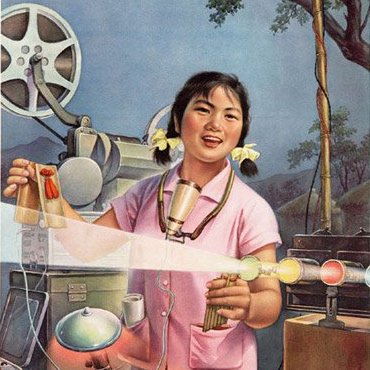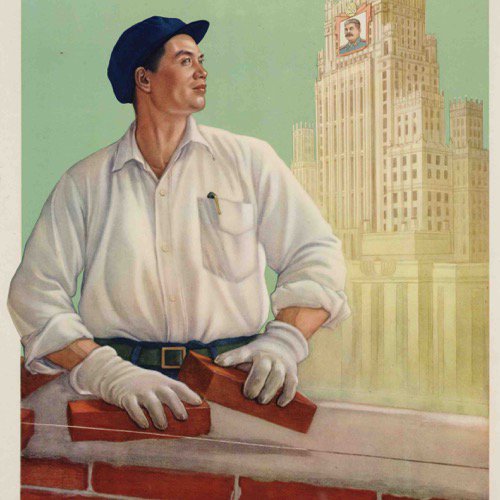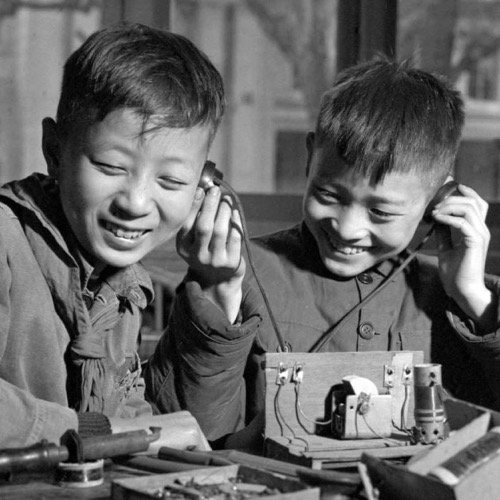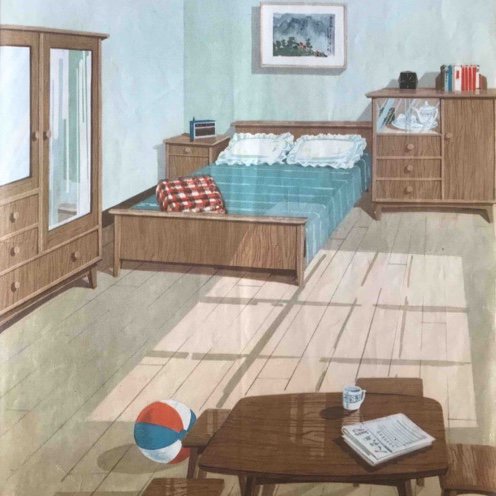Katrin Heilmann, King's College London
Summary
A symbol of the climate of fear and militarisation of everyday life during the Cold War, the air defence shelter left a lasting imprint on Chinese urban landscapes eliciting diverse local social, political and cultural responses. As a means of urban defence, shelters illustrate changing perceptions of foreign threat and its impact on everyday life during the Mao period and the Reform Era, from the rise and fall of the Sino-Soviet alliance to the Sino-American rapprochement. This bio uses the example of a specific type of shelter --the air defence tunnel-- to illustrate how perceptions of foreign threats shaped shelter construction, design and materiality.Introduction
A response to advancements in air warfare in the interwar period, the air defence shelter (fangkongdong 防空洞) was quickly integrated into state economic and strategic planning. Already the first Five-Year-Plan (1953-8) included air defence shelters. Shelters served a dual function: they provided protection and they assuaged civilian fears of vulnerability to the modern armies of China’s much more industrially developed enemies. After all, World War Two had made clear that modern airpower targeted civilians in larger urban settlements and near core industries. At times ridiculed abroad for its seeming pointlessness in the thermonuclear age considering the scale of destruction and requirement for prolonged stay in subterranean dwellings, the air defence shelter nonetheless formed part of the Global Cold War experience of the militarisation of everyday life.
Shelters were dual-use spaces. They not only temporarily accommodated people and goods, they also acted as a habitat for plants like edible fungi and --somewhat less intended-- animal populations of toads, rats and insects. This was a nuisance to many cadres assigned to maintain these underground spaces. Unlike in countries like the United States, which promoted the construction of private shelters for individual families in people’s backyards, in China until the late 1960s, as in the USSR, shelters were mainly located below public buildings. This included party and government offices, universities, shopping centres, research institutions, kindergartens, factories, hospitals, worker’s palaces as well as below selected residential compounds. Shelters offer insights into everyday militarisation during the Mao period and can help us trace how people responded to these developments.
The shelter as an object
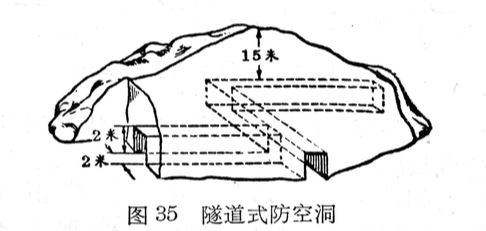
Shelters came in different sizes and designs. In the specific case of tunnels (didao 地道 or kengdao 坑道) these also had different numbers of entrances. Some shelters, including some of those dating back to the 1930s [see ⧉source: Illustrations of an early air defence shelter], were equipped with simple filtration systems and basic sanitary facilities. Others were little more than hastily dug holes in the ground. Consequently, shelters varied widely in maximum capacity, construction cost, and level of protection. Some were only partially underground, or even above ground as this Buddhist pagoda inspired above-ground shelter [see ⧉source: Illustrations of Mao-era shelters, Image 1 Buddhist-pagoda style above-ground shelter]. Already during the Second World War, there were efforts to standardise shelters as engineers and air defence specialists issued construction standard guidelines for wider circulation. In addition, air defence programmes sought to take advantage of local conditions by using for instance natural caves as a basis for shelters [see ⧉source: Illustrations of Mao-era shelters, Image 2, also depicted to the right].
Depending on the design, different materials including wood, bamboo, steel, bricks, and reinforced concrete could be used for construction. While all shelters were assemblages of different construction materials, concrete - in particular reinforced concrete - protected better from aerial bombings. Not only could it better withstand a larger conventional explosive load than other materials, it also protected more from nuclear radiation. However, frequent material shortages made it necessary to save construction materials and this led to new designs and local tweaks to existing blueprints. More sophisticated shelters included several different components such as doors, filtration, lighting and sewage systems, and this often required considerable coordination in procurement. Regardless of their degree of technical sophistication, shelters needed regular maintenance to prevent water leakage and ensure their continuing functionality.
The remainder of this object biography focusses on one particular type of shelter: the underground air defence tunnel. This particular example can help illustrate the role of the shelter in militarising Chinese civilians’ Cold War everyday reality. Tunnels were an important part of Chinese guerrilla warfare tactics used during the civil war, World War Two as well as the Korean War and later expanded during the Cultural Revolution mass movements.
Locating the shelter in Chinese history, 1930s-1969
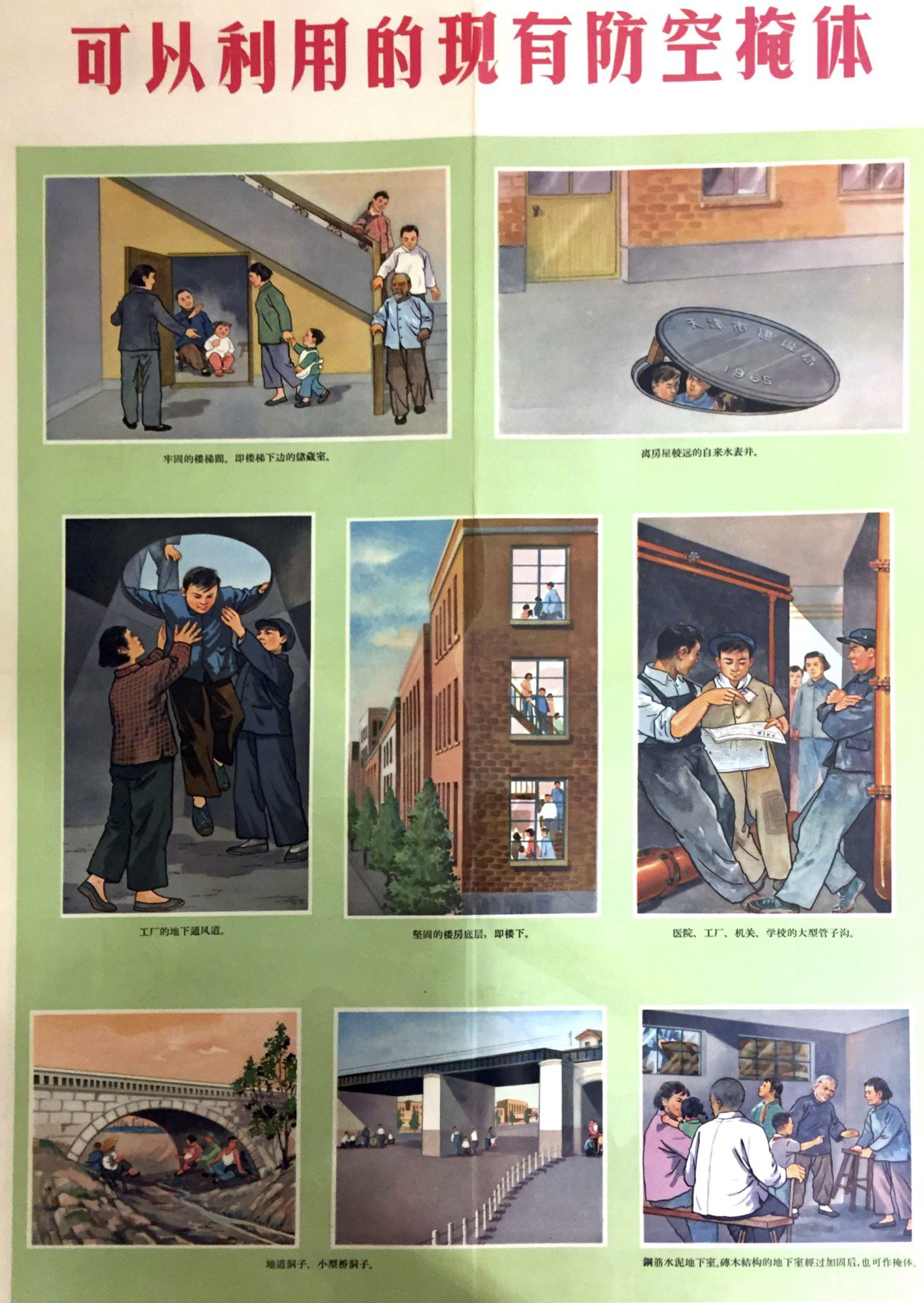
Following the 1931 Marco Polo Bridge Incident, in response to Japanese air raids, the Nationalist government started building different types of shelters including air defence tunnels in the early 1930s. There were different types of early shelters: those purpose-built for government and military officials, simple tunnels built through public mass mobilisation, and public air defence shelters part of the air defence command system. After the establishment of the PRC in 1949, the new elite decided to maintain and expand existing shelters. For instance, in response to frequent Nationalist air raids, new shelters were constructed and old ones renovated during the early 1950s in coastal areas like Fujian Province, opposite to Taiwan. By 1952, Fuzhou city had built 817 shelters, 602 air tunnels, and 276 single person shelters with an overall capacity of 70,000 people.1 Elsewhere, in the Northeast, against the backdrop of the Korean War, existing shelters were renovated and additional ones built. Shelters were either numbered and assigned to residents or tied to one’s work unit (danwei 单位) with some work units establishing dedicated air defence units. Initially, most shelters were public. This is illustrated by an 1965 Tianjin air defence poster, displayed as part of an internal exhibition [see ⧉source: The shelter in propaganda posters, Air defence education poster 'Spaces that can be used as air defence shelters', also depicted to the left].
The underground ‘Great Wall’ (地下长城)
Already during the civil war and World War Two, the Communists had used tunnel warfare as part of their guerrilla tactics. In the 1960s, the Chinese leadership used the ‘underground Great Wall’ (dixia changcheng 地下长城) to justify the extensive expansion of its subterranean tunnel networks. The term recalled the original purpose for building the Great Wall (above ground): border defence. In the 1960s, in light of the 1962 Sino-Indian Border conflict and the recurrent Nationalists raids on the coast and the American decision to send its troops to Vietnam, the CCP Central Committee decided to expand some of the existing underground tunnel networks. Propaganda films like the 1965 Tunnel Warfare (didao zhan 地道战) glorified People’s War tactics using the example of China’s resistance to the Japanese invasion during World War Two [watch ⧉source: 'tunnel warfare']. During the Cultural Revolution, the so-called ‘three old battles’ (sanlaozhan 三老战) --including Tunnel Warfare but also the 1962 Mine Warfare (dieleizhan 地雷战) and the 1952 version of Fighting North and South (Nanzhengbeizhan 南征北战)-- were screened frequently.2
However, air defence shelter construction quickly increased when Sino-Soviet relations worsened, peaking in the 1969 Sino-Soviet border conflict. During this time, the mass line3 was applied to air defence shelter construction. In an article commemorating a civil air defence chief engineer called Chen Guojing 陈国京,4 Hou Jiashang recalls Chen’s involvement in mass shelter construction: In the late 1960s, close to 2000 people worked day and night in the tunnels every day. People worked in three shifts. Work units and factories received a national subsidy of 75 yuan per square metre air defence tunnel built. During the 1950s and early 1960s, it had mostly been men who were involved in shelter construction. The 1969 mass movements, by contrast, mobilised men and women, old and young to participate in primitive shelter construction underneath work units, family homes, and schools. This broader involvement of the population did not go uncriticised. Relatives and friends of women digging shelters at times sought to discourage their participation. One way to try and keep women from digging was to allege that such an activity would impede their ability to bear children.5 More broadly, female participation in air defence shelter construction was limited to manual labour and administration including accounting and secretarial work. Men, meanwhile, mostly occupied leadership and technical positions.
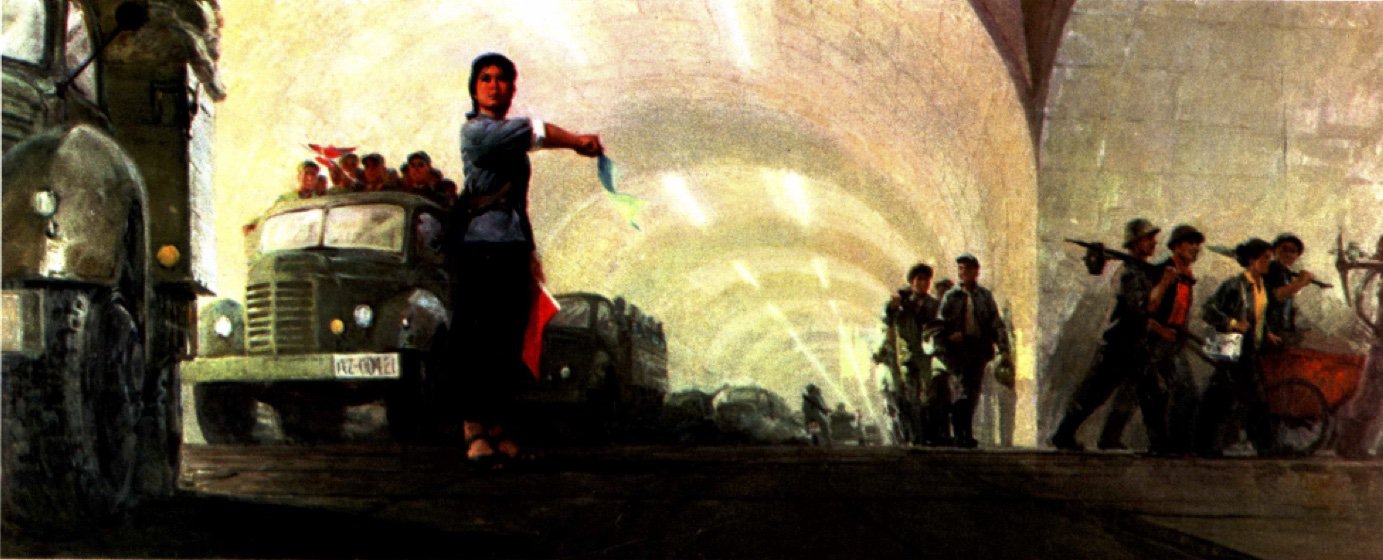
During the late 1960s and 1970s, the mass movement led to the emergence of entire subterranean tunnel networks reflected in the directive ‘dig deep shelters, store grain' [see ⧉source: The shelter in art, Image 1 ‘Dig deep shelters, store grain’ ⧉source: The shelter in art, Image 2 oil painting underground 'Great Wall', also depicted to the right]. These networks connected big and medium-sized cities with the suburbs to allow for speedy evacuation in the event of war. For example, Drew Middleton reported in the New York Times in 1976 that the 1969 campaign had resulted in more than 60,000 yards of tunnels under ‘Dairen’ (Dalian 大连) with a capacity of 50.000 people.6 Not every tunnel, moreover, was alike. Some designs came with provisions for an independent water, air, and electricity supply. Such provisions indicated that such underground spaces were built to accommodate civilians underground for several days or, if it came to the worst, a time period of uncertain length. The existence of an ‘underground’ Great Wall was well known and even featured in children’s songs [see ⧉source: shelter song]. It was also the subject of model stories: ‘model shelter diggers’ (wadong biaobing 挖洞标兵), including 103-years-old grandmothers, were publicly praised for their exemplary participation in the campaign.7
Defence was not the sole purpose of air defence tunnels: tunnel networks were also intended as spaces of life and production. Some factories moved production underground. Shelters were at times used for storage. In Zhuzhou 株洲, Hunan Province, a cake shop was relocated underground in part to escape the summer heat. During the early 1970s, however, owing to the hasty construction of these tunnels, many design flaws had become apparent: some shelters lacked adequate sealed doors, others had no ventilation systems. The lack of organisation and cooperation between individual local danwei and city and district-level long-term civil defence planning had caused some of these design flaws. Yet, official discourse did not question the existing institutional structures or the mass line and its use of mostly untrained ‘volunteers’. Instead, it blamed shortcomings on the bad influence of Lin Biao 林彪 and, after 1976, the Gang of Four.
Reform era developments
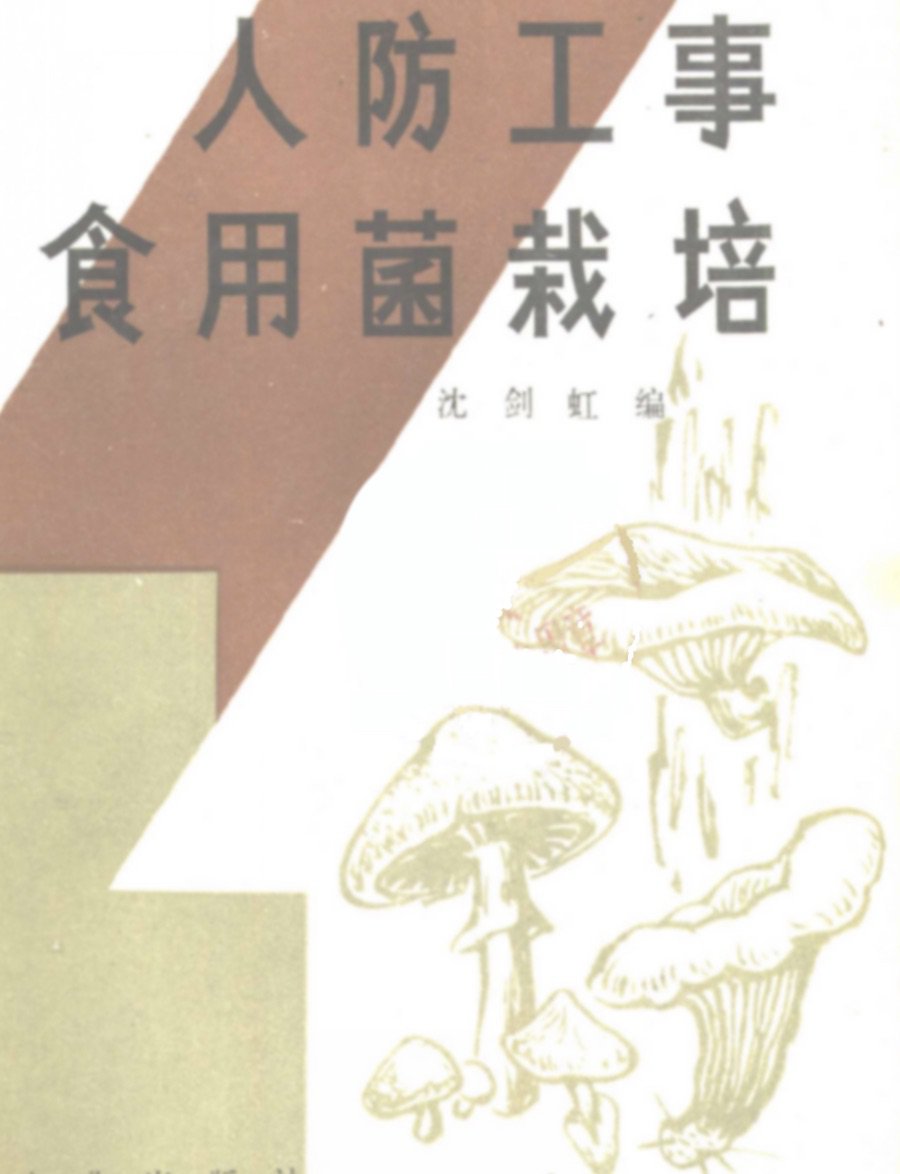
From the 1970s onwards, the dual use of shelters in war and peacetime was explored in more innovative ways. Whereas previously peacetime use of shelters had mostly been limited to underground storage, now fully equipped model shelters with electricity generators and sanitary facilities were included on foreign journalists’ and politicians’ tours of China.8 In 1976, former US President Richard Nixon was shown one of the air raid shelters sales clerks and workers had built in 1969 underneath a shopping district in Beijing. According to a Guardian article on Nixon’s shelter tour, he was told that women had made up three-quarters of the workforce [see ⧉source: Guardian Article on Nixon’s shelter visit].
With improvements in Sino-American relations, shelters were further commercialized as hotels, shopping malls, passageways, car parks, and greenhouses. As part of the larger ‘do it yourself’ trend, in 1982, the Agricultural Publishing House (nongye chubanshe 农业出版社) published a manual on the conversion of shelters into mushroom greenhouses [see ⧉source: Manual how to grow mushrooms in shelters, also depicted to the left]. According to this source, a middle school in Yangzhou City in Jiangsu Province had successfully converted 650m2 underground space into a flourishing business specialising in plant varieties including tremella (yin’er 银耳), hedgehog hydnum (houtou 猴头), and fragrant mushrooms (xianggu 香菇), generating an annual income of 190 000 RMB.
Underground greenhouses not only grew foodstuffs but also plants used in traditional Chinese medicine. The national newspaper Renmin Ribao (People's Daily) reported in 1982 that Liuyang 浏阳 township in Changsha, capital of Hunan Province, used their air defence shelters to grow gastrodia elate (tianma 天麻), a plant used in Chinese medicine, and was now in talks with a medicine company for a joint business proposal to enrich the country [see ⧉source: Underground entrepreneurship in People's Daily]. In a foreign environment that appeared to be less threatening, more varied ways of using existing underground space could be explored. No longer just a means of national defence and reminder of the Chinese people’s willingness to resort to guerrilla war if need be, the shelter had officially become an underground space that could be used to enrich the nation.
Footnotes
Fujiansheng difangzhi bianzuweiyuanhui 福建省地方志编纂委员会 (eds.), Fujian Province Gazetteer: Military Gazetteer (Fujianshengzhi Junshizhi 福建省志 军事志) (Beijing: Xinhua Press, 1995), 537.
Paul Clark, ‘The Triumph of Cinema: Chinese Film Culture from the 1960s to the 1980s’, in: Art, Politics, and Commerce in Chinese Cinema, edited by Ying Zhu and Stanley Rosen (Hong Kong: Hong Kong University Press, 2010), 92.
According to the so-called ‘mass line’, the Party would actively seek to incorporate workers, peasants and soldiers in the construction of a socialist state. As such, the 'mass line' formed the foundation for mass mobilisation for political campaigns including the 1969 shelter campaign.
Hou Jiashang 候嘉尚, ‘Building the underground Great Wall’ (dixiachangcheng de jianshezhe – jirenfanggongchengshi chenguojing 地下长城的建设者-记人防工程师陈国京) in Zhaoqingshi zhengxie wenshi ziliao bianjibu he zhaoqingshi renmin fangkong bangongshi 肇庆市政协文史资料编辑部和肇庆市人民防空办公室 (eds) Recollections from Zhaoqing City Volume 14 People's Air Defence Record (Zhaoqing wenshi di 14 ji renmin fangkong zhuanji 肇庆文史 第14辑 人民防空专辑) (Not given, 1999), 103-6.
Zhang Lu 张鹭, 'The 1969 dig shelters campaign' (‘1969 dadong shidai’ ‘1969 打洞时代’), Zhongguo Xinwen Zhoukan 中国新闻周刊 (2009): 81.
Drew Middleton, ‘Vast Arrays of Air-Raid Shelters Tunnel Under China’s Main Cities’, Special to the New York Times, 3 December 1976.
Zhang, ‘1969 dadong shidai’: 80.
Already in 1972, Western journalists visited the ‘Chien Men Way’, the tunnel shelter complex near Tiananmen Square that Nixon was shown in 1976. See James Pringle, ‘Bomb Shelter City Growing Beneath Streets of Peking’, Los Angeles Times, 26 October 1972.
Sources
- ⧉ IMAGE
- 文 TEXT
- ▸ VIDEO
- ♪ AUDIO
- ▤Pdf Air Defence Shelter: Illustrations Of Early Shelters
- ⧉Image Air Defence Shelter: Mao-era Illustrations
- ⧉Image Air Defence Shelter: The Shelter In Propaganda Posters
- ▸Video Air Defence Shelter: Tunnel Warfare
- ⧉Image Air Defence Shelter: The Shelter In Art
- ⧉Image Air Defence Shelters: Shelter Song
- 文Text Air Defence Shelter: 1976 Guardian Article On Nixon's Shelter Visit
- ▤Pdf Air Defence Shelter: How To Grow Mushrooms Underground
- 文Text Air Defence Shelter: Underground Entrepreneurship
Geography
Approximate location of the section of the Beijing Underground 'Great Wall' (Beijing dixia changcheng 北京地下长城) former US President Richard Nixon is reported to have visited in 1976.
Timeline
Further Reading
Berger Ziauddin, Silvia. ‘Superpower Underground: Switzerland’s Rise to Global Bunker Expertise in the Atomic Age’. Technology and Culture vol. 58, no. 4 (2017): 921-954.
Geist, Edward. Armageddon insurance: civil defense in the United States and Soviet Union, 1945–1991. Chapel Hill: The University of North Carolina Press, 2019.
Jin Dalu 金大陆. Feichang yu Zhengchang: Shanghai Wenge shiqide shehui shenghuo Xia (非常与正常:上海“文革”时期的社会生活 下 The Ordinary and the Extraordinary: Life in Shanghai during the Cultural Revolution Vol 2 ). Shanghai: Shanghai Cishu Chubanshe, 2011.
Macfarquhar, Roderick and Michael Schoenhals. Mao’s Last Revolution. Cambridge, MA: Belknap Press of Harvard University Press, 2006.
McMillen, Donald. ‘Civil Defence in the People’s Republic of China’. The Australian Journal of Chinese Affairs (1982): 35-50.
Ryan, Mark. ‘Early Chinese Attitudes Toward Civil Defence Against Nuclear Attack’. The Australian Journal of Chinese Affairs no. 21 (1989): 81-109.

